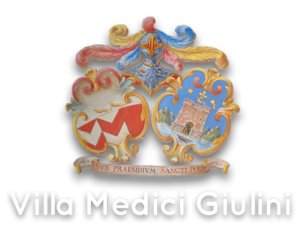Our History
Villa Medici Giulini between past and future

We could tell two stories about Villa Medici Giulini: the first concerns the ancient origins of the architectural complex that dates back to the Middle Ages, the second follows the first and tells a story that may seem incredible.
This is the official story: it was probably an ancient fortress built to guard the villages and the hypothesis is confirmed by the large barrel vaults room remained intact over time. The same position of the buildings, on the top of a hill, lays for the hypothesis of a building with a destination of “house-fort”. In the middle of the seventeenth century, the private chapel, called Saint Joseph Oratory, was created. On the altar is the altarpiece by Antonio Busca (1625-1686) depicting the Holy Family with Saint Francis. The bronze bell above the small church is engraved with the date 1643.
The buildings complex appears intact in the map of Maria Teresa dated 1721 and it was never substantially modified over the centuries. At the end of the 18th century the empty space between the two Cappuccine was created and the Italian garden was designed, as it is still today.
The history of Villa Medici Giulini details the different owners following each other in time, from the middle of the seventeenth century until today. At the end of the eighteenth century, Francesco Zuccarelli decorated the hall of honor of the first floor with six grandiose tempers that probably represented the villages that were part of the estate, certainly very extensive. The villa then became a “villa of delight”. The surrounding countryside was cultivated with mulberry trees and vines, as it was used for a “villa-farm”.
The property passed to Giulini’s in 1981 and the restoration of the historic residence and the garden gave the complex its former glory. A video tells the guests the history of the family and its relationship with Villa Giulini.
Fernanda Giulini then discloses the secret story, her first meeting with the house. “It was a Sunday in October and the search was directed, ironically, to a pied-à-terre in the surroundings of Milan. In those years, ads were read on Il Corriere della Sera and the description of Villa Medici was particularly attractive, because of its proximity to Milan.
So I found myself in front of an abandoned magnificent garden, with hornbeams intensely yellow and unhooked due to the first autumn cold, the secular plants that witnessed a great past and the Italian garden, remained intact as by miracle. Beauty and oblivion could not unite better.
The villa had open windows, as it was used to “air the rooms” and was still beautiful, with painted ceilings in the bedrooms, the ancient Lombard terracotta on which was still present the “lipstick” and the splendour of the painted hall on the first floor.
The surprise was indescribable. The rooms were empty of furniture, but with a perfect “escape” from one room to another, almost an invitation to revive the old manor that had kept perfect architectural volumes.
The invitation was received with passion, perhaps not thinking about the great deal of the restoration that would give back the ancient splendour to a place where music peeped out from the painted lunettes and the book written by Nerina Medici Marignano with the description of the theatrical performances of a time gone by.
The restoration was easy, because it was enough to make “talk” the places where history had stopped, waiting for “a vague madness” – according to the definition of Maestro Riccardo Muti – that made Villa Medici return to its ancient splendour. That’s how fate gave birth to “The Villa of the lost sounds”.
The property passed to my family from Ignazio Vigoni, our distant cousin himself a relative of the Medici of Marignano. The correct name should be Villa Giulini, but the past must be respected, as is customary in homes that have had a great history.”
A selection of pictures of the Villa history
del 1721
nella mappa del 1721
di Antonio Busca
Villa Bolognini
disegno a penna
dei proprietari


